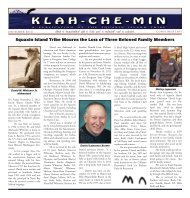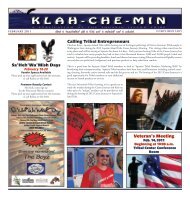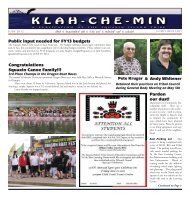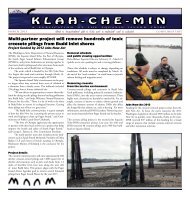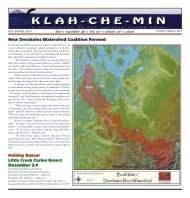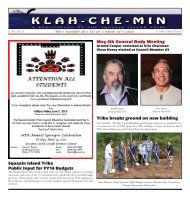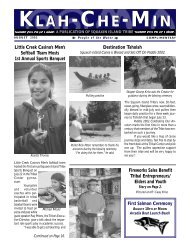Canoe Journey Guidebook - Squaxin Island Tribe
Canoe Journey Guidebook - Squaxin Island Tribe
Canoe Journey Guidebook - Squaxin Island Tribe
Create successful ePaper yourself
Turn your PDF publications into a flip-book with our unique Google optimized e-Paper software.
In 1993, the <strong>Squaxin</strong> <strong>Island</strong> <strong>Tribe</strong> participated in an inter-<br />
Tribal visioning session for cultural resurgence. The cedar canoe<br />
was identified as the common thread between the <strong>Tribe</strong>s to bring<br />
the cultural teachings back to the Tribal people.<br />
In March 1994, the <strong>Squaxin</strong> <strong>Tribe</strong> hosted the Healing of the<br />
Waters Ceremony at Percival Landing in Olympia. <strong>Tribe</strong>s from<br />
Washington and Canada brought their canoes as a way of honoring<br />
and celebrating. In 1996, the <strong>Squaxin</strong> <strong>Island</strong> <strong>Tribe</strong> invited<br />
<strong>Canoe</strong> Nations to join in the dedication of the newly reacquired<br />
Shaker Church property. After the dedication, the Tribal canoes<br />
circled <strong>Squaxin</strong> <strong>Island</strong>, stopping at North, East, South and West.<br />
At each stop a prayer was given in a song or audible prayer.<br />
In 1995, the <strong>Tribe</strong> obtained permission from the National Forest<br />
Service to remove two enormous cedar trees that had fallen in<br />
the Wynoochee Valley in 1993. Being more than 500 years old,<br />
the trees were alive before the arrival of Christopher Columbus.<br />
Before the trees were taken out of the forest, they were blessed<br />
and prayed over. They were cut into two 50-foot sections and one<br />
30-foot section. Simpson Timber Company donated the use of<br />
its largest CAT and logging truck to haul the 22,000-pound logs.<br />
Then, when the truck was safely on its way to the <strong>Squaxin</strong> <strong>Island</strong><br />
Tribal Center, a new cedar tree was planted and blessed.<br />
The cedar logs arrived at the <strong>Squaxin</strong> <strong>Island</strong> Tribal Center on<br />
March 30, 1996, and a blessing ceremony took place there on<br />
April 4, 1996.<br />
Charlene Krise, a Tribal cultural leader, asked her brother, David<br />
“George” Krise, to be head carver on the canoe project. Since<br />
1994 George and his wife, June Krise, dedicated themselves<br />
to participating in the inter-Tribal canoe journey. Each year<br />
they would take <strong>Squaxin</strong> youth with them. George had never<br />
carved a canoe, yet made every effort to learn all he could<br />
to start the project. George and a number of other <strong>Squaxin</strong><br />
<strong>Island</strong> Tribal members were guided by the late Tulalip Tribal<br />
member Jerry Jones who was employed at the Tulalip <strong>Tribe</strong>’s<br />
Cultural Resources Department. He built gill-netters for many<br />
years, assisted in the design of superstructure for the Seattle,<br />
Wenatchee and Spokane ferries, and completed a canoe project<br />
as documented by Local CBS News Affiliate, KIRO Television.<br />
In 2002, for the first time in more than a century, members of<br />
the <strong>Squaxin</strong> <strong>Island</strong> <strong>Tribe</strong> embarked upon a more than 200-mile<br />
paddle from south Puget Sound, through the Straits of Juan de<br />
Fuca and then on to the Quinault Tribal Nation on the Pacific<br />
Ocean coast.<br />
Today, the <strong>Squaxin</strong> <strong>Island</strong> <strong>Canoe</strong> Family has both a fiberglass<br />
and the cedar canoe.<br />
This year, the <strong>Squaxin</strong> <strong>Island</strong> <strong>Tribe</strong> broke ground on its new<br />
canoe-carving shed. It is expected to be completed by the time<br />
the hosting of the 2012 <strong>Canoe</strong> <strong>Journey</strong> begins.<br />
praying for us all. The weary paddler<br />
resting is still ballast. And there is<br />
always that time when the crew needs<br />
some joke, some remark, some silence<br />
to keep going, and the least likely<br />
person provides.<br />
5We all pull and support each other<br />
- Nothing occurs in isolation. When<br />
we aren’t in the family of a canoe, we<br />
are not ready for whatever comes. The<br />
family can argue, mock, ignore each<br />
other at its worst, but that family will<br />
never let itself sink. A canoe that lets<br />
itself sink is certainly wiser never to<br />
leave the beach. When we know that<br />
we are not alone in our actions, we also<br />
know we are lifted up by everyone else.<br />
6A hungry person has no charity -<br />
Always nourish yourself. The bitter<br />
person, thinking that sacrifice means<br />
self-destruction, shares mostly anger.<br />
A paddler who doesn’t eat at the<br />
feasts doesn’t have enough strength<br />
to paddle in the morning. Take that<br />
sandwich they throw at you at 2.00 a.m.<br />
The gift of who you are only enters the<br />
world when you are strong enough to<br />
own it.<br />
7Experiences are not enhanced<br />
through criticism - Who we are,<br />
how we are, what we do, and why wen<br />
continue, flourish with tolerance. The<br />
canoe fellows who are grim go one way.<br />
The men and women who find the lightest<br />
flow may sometimes go slow, but<br />
when they arrive they can still sing. And<br />
they have gone all over the sea, into the<br />
air with the seagulls, under the curve of<br />
the wave with the dolphin and down to<br />
the whispering shells, under the continental<br />
shelf. Withdrawing the blame<br />
helps each o acknowledge how wonderful<br />
a part of it all every one really is.<br />
8The journey is what we enjoy -<br />
Although the start is exciting and<br />
the conclusion gratefully achieved, it is<br />
the long, steady process we remember.<br />
Being part of the journey requires great<br />
preparation; being done with a journey<br />
requires great awareness; being on<br />
the journey, we are much more than<br />
ourselves. We are part of the movement<br />
of life. We have a destination, and for<br />
once our will is pure, our goal is to go<br />
on.<br />
9A good teacher allows the student to<br />
learn - We can berate each other, try<br />
to force each other to understand, or we<br />
can allow each paddler to gain awareness<br />
through the ongoing journey. Nothing<br />
sustains us like that sense of potential<br />
that we can deal with things. Each<br />
paddler learns to deal with the person in<br />
front, the person behind, the water, the<br />
air, the energy; the blessing of the eagle.<br />
When given any choice at all - be<br />
10 a worker bee and make honey!<br />
99 • • paddle paddle to to squaxin squaxin 2012 2012




